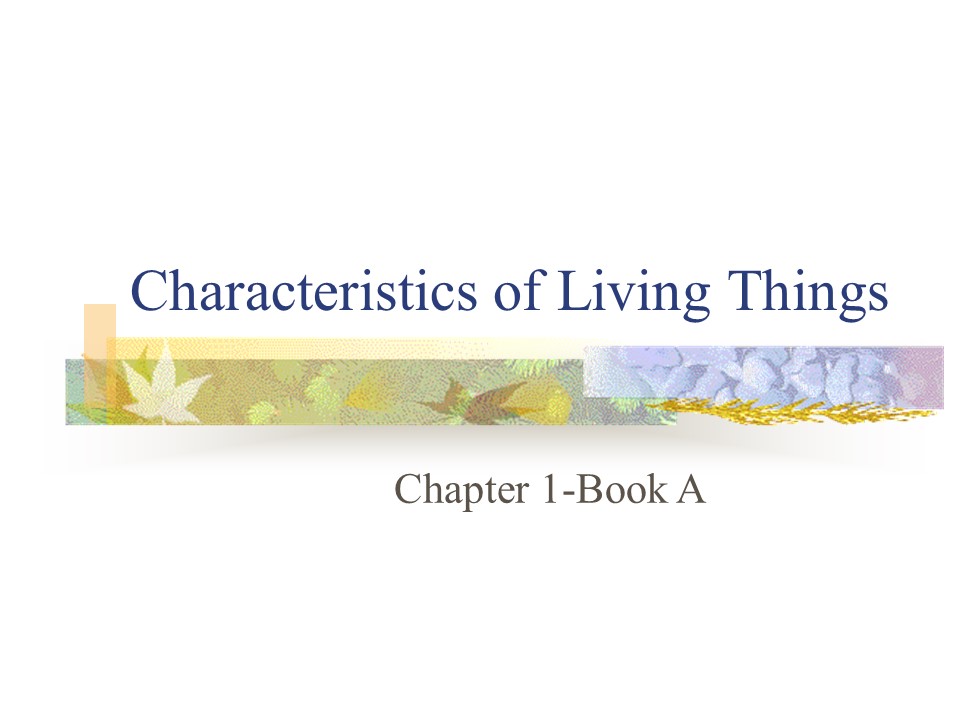Characteristics of Living Things - PowerPoint PPT Presentation
Title:
Characteristics of Living Things
Description:
Characteristics of Living Things Chapter 1-Book A Initial Questions What do plants have in common with dogs? What do bacteria have in common with fish What people ... – PowerPoint PPT presentation
Number of Views:575
Avg rating:3.0/5.0
Title: Characteristics of Living Things
1
Characteristics of Living Things
- Chapter 1-Book A
2
Initial Questions
- What do plants have in common with dogs?
- What do bacteria have in common with fish
- What people have in common with SLIME MOLD?
3
Living things have cells
4
Cells
- A cell is the smallest unit that can perform all
life processes - Cells are covered by a membrane and have DNA and
cytoplasm - Most cells cannot be seen with the naked eye
5
Cell functions
- Some organisms are made up of TRILLIONS of cells
- Different types of cells have different functions
- For instance.nerve cells transport signals and
muscle cells are specialized for movement! - In organisms with one cell, different parts of
the cell performs different functions (in a
paramecium, part of the cell will eat, for
example)
6
STIMULUS
- Stimulus anything that causes a reaction or
change in an organism or any part of an organism - ALL organisms have the ability to sense change in
their environment, and to respond to that change - How do pupils respond to light?
- Stimuli (plural) can be light, chemicals,
gravity, sounds, hunger, or ANYTHING that causes
an organism to respond in some way
7
Example of Stimulus in Nature
8
Brainpop Video on the Venus Fly Trap
- http//www.brainpop.com/science/diversityoflife/ca
rnivorousplants/
9
Homeostasis
- Organisms must maintain a stable internal
environment.. - For instance, what is the average human body
temperature? - Homeostasis is the maintenance of a constant
internal state in a changing environment
10
Brainpop video on homeostasis
- http//www.brainpop.com/health/endocrinesystem/hom
eostasis/
11
Responding to External Changes
- What happens when you get hot? Why?
- What happens when you get cold? Why?
- Whether youre sweating or shivering, your body
is trying to return itself to normal temperature - Animals control their temperature by moving from
one environment to the other
12
Living things reproduce
- Organisms make other organisms similar to
themselves - Sexual reproduction-reproduction in which the sex
cells from two parents unite, producing offspring
that share traits from both parents
13
Asexual Reproduction
- Asexual reproduction reproduction that does not
involve the union of sex cells and in which on
parent produces offspring identical to itself - Many invertebrates are asexual, as do single
celled organisms
14
Brainpop Video on Asexual Reproduction
- http//www.brainpop.com/science/reproductionandher
edity/asexualreproduction/
15
Living Things have DNA
- DNA-stands for deoxyribonucleic acid
- Controls the structure and function of the cell
- When organisms reproduce, they pass copies of
their DNA to their offspring (therefore
offsprings DNA resembles their parents DNA) - Passing of traits from one generation to the next
is call HEREDITY
16
Living things use energy
- Organisms use energy to carry out all life
activities (making food, breathing, walking) - METABOLISM the sum of all chemical processes
that occur in an organism
17
Living things grow and develop
- ALL living things grow
- Single-celled organisms the cell gets larger and
divides, making other organisms - In other organisms, the number of cells grow, and
the organism gets bigger - Animals/humans also develop as they go through
different life stages































